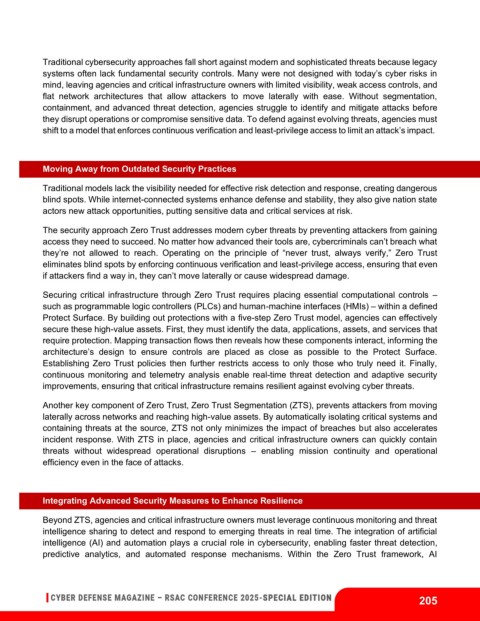Page 205 - Cyber Defense eMagazine RSAC Special Edition 2025
P. 205
Traditional cybersecurity approaches fall short against modern and sophisticated threats because legacy
systems often lack fundamental security controls. Many were not designed with today’s cyber risks in
mind, leaving agencies and critical infrastructure owners with limited visibility, weak access controls, and
flat network architectures that allow attackers to move laterally with ease. Without segmentation,
containment, and advanced threat detection, agencies struggle to identify and mitigate attacks before
they disrupt operations or compromise sensitive data. To defend against evolving threats, agencies must
shift to a model that enforces continuous verification and least-privilege access to limit an attack’s impact.
Moving Away from Outdated Security Practices
Traditional models lack the visibility needed for effective risk detection and response, creating dangerous
blind spots. While internet-connected systems enhance defense and stability, they also give nation state
actors new attack opportunities, putting sensitive data and critical services at risk.
The security approach Zero Trust addresses modern cyber threats by preventing attackers from gaining
access they need to succeed. No matter how advanced their tools are, cybercriminals can’t breach what
they’re not allowed to reach. Operating on the principle of “never trust, always verify,” Zero Trust
eliminates blind spots by enforcing continuous verification and least-privilege access, ensuring that even
if attackers find a way in, they can’t move laterally or cause widespread damage.
Securing critical infrastructure through Zero Trust requires placing essential computational controls –
such as programmable logic controllers (PLCs) and human-machine interfaces (HMIs) – within a defined
Protect Surface. By building out protections with a five-step Zero Trust model, agencies can effectively
secure these high-value assets. First, they must identify the data, applications, assets, and services that
require protection. Mapping transaction flows then reveals how these components interact, informing the
architecture’s design to ensure controls are placed as close as possible to the Protect Surface.
Establishing Zero Trust policies then further restricts access to only those who truly need it. Finally,
continuous monitoring and telemetry analysis enable real-time threat detection and adaptive security
improvements, ensuring that critical infrastructure remains resilient against evolving cyber threats.
Another key component of Zero Trust, Zero Trust Segmentation (ZTS), prevents attackers from moving
laterally across networks and reaching high-value assets. By automatically isolating critical systems and
containing threats at the source, ZTS not only minimizes the impact of breaches but also accelerates
incident response. With ZTS in place, agencies and critical infrastructure owners can quickly contain
threats without widespread operational disruptions – enabling mission continuity and operational
efficiency even in the face of attacks.
Integrating Advanced Security Measures to Enhance Resilience
Beyond ZTS, agencies and critical infrastructure owners must leverage continuous monitoring and threat
intelligence sharing to detect and respond to emerging threats in real time. The integration of artificial
intelligence (AI) and automation plays a crucial role in cybersecurity, enabling faster threat detection,
predictive analytics, and automated response mechanisms. Within the Zero Trust framework, AI
205

